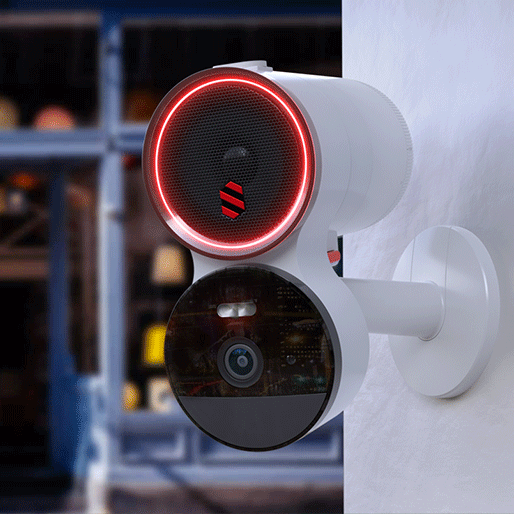What Is a Perimeter Intrusion Detection System?

As far as securing an area goes, fences are a great foundation. They create the first line of defense and a powerful visual deterrent for criminals looking to go where they’re not supposed to be. But they’re not infallible. Fences can be climbed, cut, torn down, or tunneled under. You can fortify them with stronger steel, make them higher, or add barbed wire, but they still might fail you one day. And unless you immediately know when someone has breached that perimeter, a fence is hardly more than a decoration. Fences need a little help, and a perimeter intrusion detection system can fill that role. But what is a perimeter intrusion detection system? And how does it protect you?
What is a Perimeter Intrusion Detection System?
As the name suggests, a perimeter intrusion detection system—aka PIDS—is a system of sensors that detects an intruder whenever a fence or wall is climbed, cut, or otherwise disturbed. It provides a failsafe for what is already a decent obstacle.
Proper perimeter protection should use the 5 “D”s of perimeter security, starting with the outermost boundary and working in:
- Deter (the presence of fences and other barriers)
- Detect (PIDS and security cameras to alert you to unauthorized access and intrusion)
- Deny (access control, security checkpoints, etc.)
- Delay (locked doors and other physical barriers, security cameras for situational awareness)
- Defend (security personnel or police)
Perimeter intrusion sensors provide better protection than fences and barriers alone. Along with a comprehensive security system, a PIDS is typically deployed around a high-security environment. The most common spots are prisons, military bases, airports, and government buildings. And, increasingly, around businesses, residential properties, and more.
A perimeter alarm system can range from low- to high-tech. For a simple analog example, picture a tripwire attached to a bell. A more advanced solution would be something like the seismic sensors that detect vibrations of the earth. No matter the type, they alert you to intruders breaching your outer perimeter before they have a chance to tackle your inner perimeter (doors, windows, and so on). Think of it as an early alert system that gives you time to intervene, call authorities, strengthen inner defenses, and so on.
The U.S. Army divides PIDS technology into several different categories. But let’s dig in a little deeper.
Types of Perimeter Security Systems
The end goal is the same, but PIDS can take one of several different forms:
- Break wire
- Taut wire
- Active IR
- Passive IR
- Near-IR beam break
- Electrostatic field
- Magnetic
- Microwave
- Ported coaxial cable
- Ground motion
- Seismic
- Fence detection (including microphonic cable and accelerometer)
Most PIDS are barrier-mounted, attached to a fence or wall, while some are ground-based or below-ground (these do not require a physical barrier). What works best depends on your location and specific needs.
Next, let’s examine a few of the most common and practical perimeter intrusion detection systems.
Security Cameras
Security cameras on the property’s perimeter—either motion-activated or live streaming—are an affordable and user-friendly PIDS. These allow owners, site supervisors, security personnel, or any other stakeholder to keep a watchful eye on the outer boundary.
To be effective, a security camera system needs live video monitoring.

Motion-Activated Floodlights
Another great low-cost solution, motion-activated floodlights eliminate the cover of darkness, increase the risk of getting caught, and grab attention when flicking on in the middle of the night. They leave nothing hidden.
As you’d expect, would-be intruders want nothing to do with them.
Electrified Fences
Not the most subtle option, an electrified fence delivers a non-lethal shock to anyone that touches it. What’s more, it can trigger an alarm when it administers that shock or if the fence is cut or disturbed.
This option might be too intensive for open-to-the-public businesses and residential properties that want to welcome guests during parts of the day. So choose wisely.
Passive Infrared Sensors
Passive infrared (PIR) sensors detect motion along a perimeter. They measure the infrared light—heat energy in the form of electromagnetic radiation—coming from objects within their field of view.
Any change is interpreted as a movement by a person or animal, triggering an alarm. PIR sensors have an effective range of roughly 10 meters and may produce false alarms because of natural temperature changes.
Active Infrared Sensors
These sensors require at least one transmitter and one receiver. The transmitter shoots out an invisible beam of infrared light aimed at the receiver. If nothing is in the way, the receiver “sees” the beam. However, if a person walks through or stands between them, they interrupt the beam and trigger an alarm. Many homeowners have a similar setup on their home garage door to prevent it from closing when something is in the way.
Obviously, you need clean and direct sightlines between the components for the system to operate in the first place. These sensors are susceptible to false alarms from animals, heavy fog, and the like. AIR sensors have a range of up to 200 meters.
Microwave Sensors
Microwaves are yet another type of electromagnetic radiation with shorter wavelengths than radio waves, hence the “micro-” prefix.
These waves use radiolocation, which is similar to the echolocation used by bats and dolphins. An emitter sends microwaves out, they bounce back off objects in the area, and they are then interpreted by a receiver. In this way, they can detect not only movement but direction and speed as well via the Doppler effect.
Compared to infrared sensors, they’re more expensive and more prone to false alarms. But they’re capable of covering a larger area and are not susceptible to weather conditions.
Vibration Sensors
Simple and straightforward, vibration sensors detect and report vibrations outside of an acceptable range. Someone cutting, climbing, lifting, or shaking a fence will create vibrations. So, too, will someone trying to force their way in through a door or window.
Once a vibration meets the preset threshold, an alarm triggers. Vibration sensors can precisely locate an intruder.
Fiber Optic Cable
Used on a fence or buried underground, fiber optic cable is a precise perimeter intrusion detection system. Typically employing vibration as the detection technique, fiber optic cable provides long-range coverage—up to 100 km per processing unit—with zero gaps.
The RaySense system, for example, measures the “Rayleigh backscatter noise signature in a fiber optic cable as pulsed light is sent into the fiber.” In doing so, it can detect vibrations along the entire length of the cable and differentiate between a breach, cut, climb, or non-threatening intruder such as a squirrel.
Microphonic Cable
Installed along the length of a metal perimeter fence, a microphonic cable detection system analyzes noise patterns to identify an attempted intrusion. The Micalert system from RBtec, for example, has a maximum length of 2000 feet per processor. It boasts fast plug-and-play installation.
Precise calibration and system sensitivity are important for this PIDS to operate properly. A self-calibrating system is ideal.
Laser Tripwire/Fence

As you may already know, a laser—which stands for light amplification by stimulated emission radiation—is an artificially created beam of light. The light waves travel in phases—peaks and valleys lined up—which allows them to stay very narrow, focused, and bright. The beam can also travel great distances without scattering.
Similar to the infrared perimeter intrusion detection system, a laser perimeter alarm consists of two components: a transmitter that emits a continuous laser beam and a receiver. As long as there is a clear line of sight, the distance between them is irrelevant. Anything passing between them will break the beam and trigger the alarm.
Seismic Detectors
Though you might associate these sensors with their traditional use in tracking earthquakes, seismic detectors are becoming increasingly popular in both home and business security.
Consisting of multiple sensors buried underground and a processor, a seismic perimeter alarm system can detect footsteps and vehicles atop the protected area. The processor analyzes the acoustic signature of the event to identify an individual walking or a vehicle driving over the sensors and triggers an alarm based on your settings.
And because no barrier is required and the system is underground, it is virtually undetectable to the unsuspecting intruder.
The Deep Sentinel Solution
These PIDS options offer powerful protection for your outer perimeter. But unless someone actively monitors the system, an alarm may be too late. Deep Sentinel is proud to offer proactive perimeter protection for businesses either in place of or in collaboration with other systems.
How? A surveillance camera system armed with AI monitors your perimeter and instantly notifies live security guards if someone is onsite. The guards assess the situation and engage with the suspect via 2-way audio, triggering a loud siren and notifying police if necessary.
Deep Sentinel prevents crime before it happens by offering affordable perimeter protection with live guards. Stop intruders well before they reach the front door with a perimeter intrusion detection system designed for the modern age.
Need a Solution that Prevents Crime?
Deep Sentinel is the only security technology that delivers the experience of a personal guard on every customer’s home and business. Visit deepsentinel.com/business or call 833-983-6006

